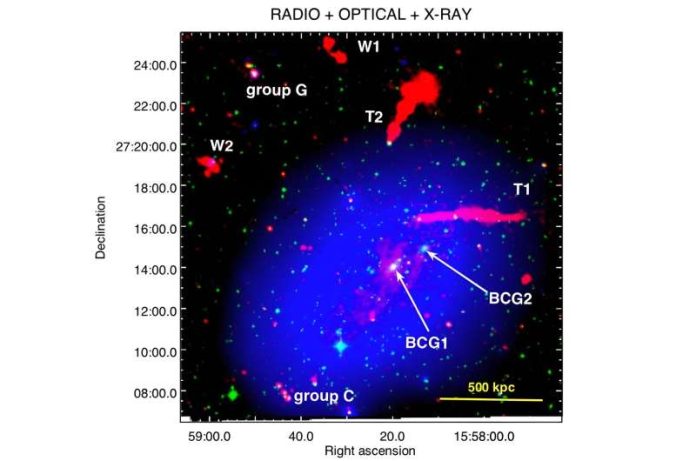
Imagine a cluster of galaxies as a jigsaw puzzle, but not just any puzzle. It’s one of those 1,000-piece challenges where every piece is crucial.
Scientists from the University of Bologna in Italy and other places have been focusing on one such puzzle, a galaxy cluster named Abell 2142.
It’s far, far away—1.24 billion light-years to be exact. This cluster is like a cosmic laboratory, perfect for understanding how galaxies evolve and how the universe works.
Now, thanks to some high-tech radio observations, they’ve found a new piece in this cosmic puzzle.
Spotting the Invisible: How They Did It
Radio halos are like invisible paint splatters at the centers of galaxy clusters. They’re super tough to spot because they’re really faint, especially when you’re trying to look at them with ordinary tools.
But the LOw Frequency ARray (LOFAR), a fantastic telescope designed for this kind of work, can catch these elusive splatters in high detail. The researchers used LOFAR to zoom in on Abell 2142.
The New Discovery: Meet H3
Before this study, scientists knew this galaxy cluster had a big radio halo with two main parts. They called these H1 and H2. Think of H1 as the core—bright and round.
H2 is more like the outskirts—bigger but fainter and stretched out. But when the team looked closer using LOFAR, they spotted something new—a third part, which they’re calling H3.
H3 is pretty massive, stretching over about 7.8 by 6.5 million light-years. It also seems to follow the X-ray patterns of the cluster, suggesting it’s a crucial part of the picture.
The researchers are calling it a “giant ultra-steep spectrum radio halo,” which in simple terms means it’s a big, important new piece of this galactic puzzle.
What’s Next: The Origin Story of H3
So, where did this H3 come from? The scientists have a couple of ideas.
It might have been formed by an old, high-energy collision between galaxies or by smaller, ongoing mix-ups that stirred the pot and created this new feature.
Either way, H3 adds a new layer to our understanding of galaxy clusters and the universe.
This research doesn’t just add another piece to the Abell 2142 puzzle; it opens up new questions and possibilities for understanding the cosmos.
And who knows, the next big discovery could be just another telescope observation away.
The study was published in arXiv.



